#carlotta by adelina patti
Explore tagged Tumblr posts
Text
That One Reference to That One Musical In Lies of P (that I think only I noticed)
Yeah you heard me.
Aside from the multitude of Pinocchio characters that litter the entirety of Krat, there's also a few other characters that are a reference to other things if you look hard enough. Veningi and his references to Batman, Giango and his reference to an actual famous alchemist - so on and so forth.
But there's one particular pair I don't see get mentioned in that list and would like talk about more:
The Red Actress and The White Lady
(spoilers below cut)
So first off there's actually two references between these characters - a reference to a musical AND a reference to a fairy tale - but since I said musical in the title I'll start off there.
Before we can reach the King of Puppets at the Estella Opera House, we have to brawl our way through Rosa Isabelle Street which is connected to Hotel Krat. If you roam around a bit, you get to encounter one of the fanciest Stalker bosses that wander the formerly entertaining street - The White Lady.
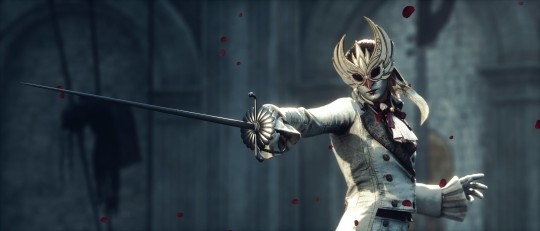
And no, her name is not Karen, but we'll learn that eventually.
Apart from being a difficult boss encounter and having the coolest outfit and mask EVER, her voice lines reveal early on that she is the sister of the famous Adelina Corday, the Red Actress. Given how devastating the Puppet Frenzy has been for every party involved, it's unsurprising that she takes her frustration and grief out on every puppet she comes across as it's likely her sister has perished to the hands of said puppets. Her locket even shows how close they were, wishing to share the stage of their dreams alongside each other.
Or so we presume.
After fighting our way through the streets we can finally reach the Opera House and encounter Adelina herself, tucked away in a side hall attempting to sing a song with her petrified throat and apologize to a woman named "Patricia". From there you can take on her last request - to feed her a plump apple full of juice to quench her thirst and restore her parched throat (using the Red Apple you can purchase from Polendina after finding a Krat Supply Box).
If you don't find her prior to fighting the King of Puppets, however, you only find her dead body lying on the ground with a locket containing a torn portrait of a girl and a scratched out name. Finding her prior to the fight will reward you her record "Fascination" along with said locket.

Now if you guys aren't getting the musical references yet (The White Lady's white mask, this Actress, and the ghastly theater with a swinging Chandelier prior to entering the King's boss arena) they're a nod to the Phantom of the Opera musical. However, Adelina's not a reference to the protagonist, Christine Daae -- she's actually a reference to Daae's rival, the Prima Donna Carlotta.
See, the characters Christine Daae and Carlotta were actually based on two real opera singers who also shared a rivalry: Christina Nilsson (left) as Christine Daae and -- wait for it -- Adelina Patti (right) as Carlotta Giudicelli who, in some adaptations, wore red as her main color.
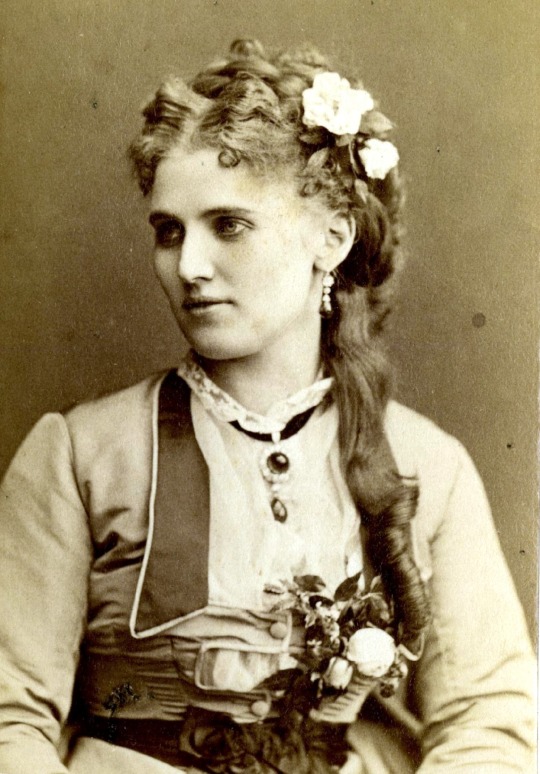
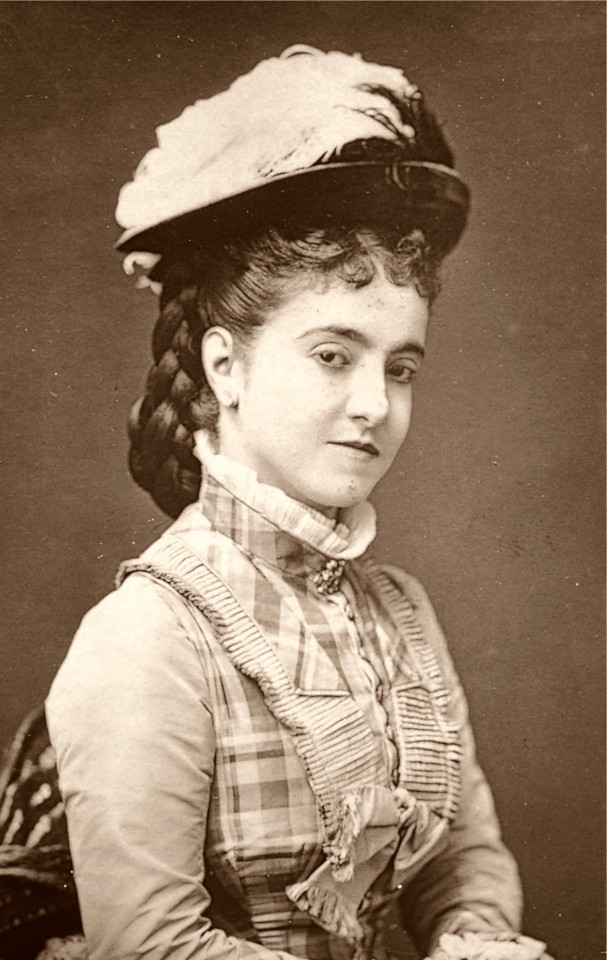
The reason that's so important is because when you complete her quest, Adelina in the game asks that we listen to her final confession before she dies: while striving for stardom her jealousy provoked her to get rid of her biggest rival by tricking her into drinking poison that would ruin her throat and prevent her from singing for good:
Patricia Corday, her sister, whom she is uncertain about the fate of given that she is unable to leave the Opera House.
Well, we know what happens.
We kill her prior to arrival, not as Patricia Corday but as the White Lady.
Yeah. Kinda messed up ;-;
So now aside from being the angelic singer who could have become "The White Goddess" according to one of her fans, The White Lady has become the Phantom of the Opera herself as she is unable to show her face on stage due to the lack of singing voice after being poisoned. Or you could argue Adelina became the Phantom as she's the one who dies alone in the Opera House. Either way, both sisters suffer a horrible fate apart from each other, with neither knowing what happened to the other.
Speaking of sisters, guess what fairy tale involves a pair of color coded sisters written by the Grimm brothers:
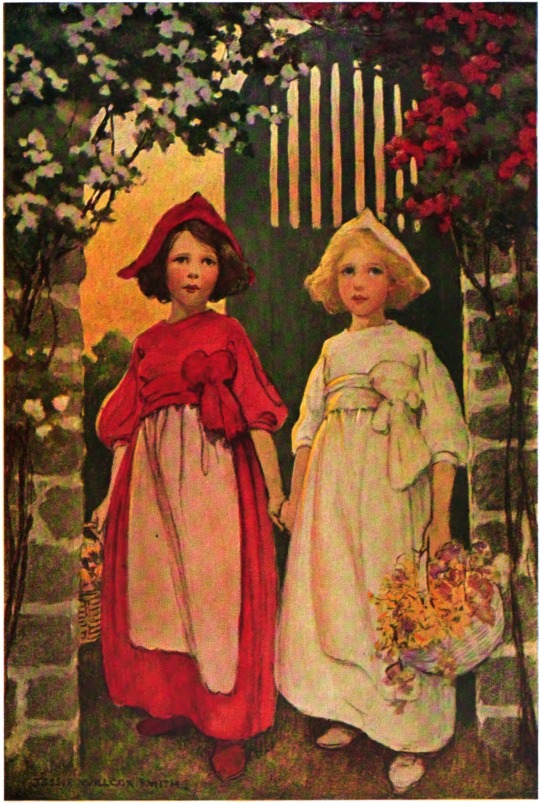
Snow White and Rose Red
Now I know the two aren't related to the other Snow White fairy tale (also written by the Grimm bros) but given how much crossover references are in Lies of P it doesn't surprise me Neowiz decided to merge the two stories together so bear with me.
The sisters can fill in each other's roles as Snow White (The White Lady) and Rose Red (The Red Actress), but the rest of their story follows the original Snow White and the Seven Dwarves:
Adelina, the jealous sister, tricks Patricia into drinking poison that ruins the source of her charm the same way the jealous step mother tricks Snow White into eating a poisonous apple so she can be the prettiest person on the planet. Ironically, Adelina is the one who perishes after eating an apple - petrified and frozen by the disease, while Patricia became her own Prince by becoming a Stalker after her voice became ruined.
It's a loose reference, sure, but honestly it's a pretty cool one nonetheless!
I'm really looking forward to all the other references the game devs decide to hide in Lies of P (heck I didn't even put together Champion Victor being a Frankenstein reference or Murphy the Robo Cop boss), along with maybe future games they have in store (I see you Rise of P ending I know).
But I'll end my thoughts here for now! Check out the game yourself if you ever get the chance, it's SO worth it!!
#lies of p#lop#lies of p spoilers#lop spoilers#adelina corday#adelina the red actress#the red actress#the white lady#white lady boss#patricia corday#text post
46 notes
·
View notes
Text
Some figures whom I think looks kinda like how I imagine these figures to look like in their respective books/plays/legends
. Christine Daae ( POTO ) - Catherine Deneuve, Sissel Kyrkjebo, Christine Nilsson, Emmi Christensson, Ingrid Bergman
. Meg Giry ( POTO ) - Maria Khoreva, Leslie Caron
. Natasha Rostova ( War and Peace ) - Lyudmila Saveleva, Audrey Hepburn
. Cosette ( Les Mis ) - Rebecca Caine, Judy Kuhn, Isabelle Huppert, Adele Foucher
. Tatiana Larina ( Eugene Onegin ) - Liv Tyler
. Eponine ( Les Mis ) - Samantha Barks, Frances Ruffelle
. Raoul De Chagny ( POTO ) - Vincent Cassel ( especially when younger ), Steve Barton
. Marius Pontmercy - Michael Ball, Victor Hugo ( especially when younger )
. Mr Darcy - Colin Firth
. Elizabeth Bennet - Jennifer Ehle, Jane Austen
. Juliet Capulet - Olivia Hussey
. Jane Bennet - Susannah Harker, Rosamund Pike
. Daisy Fay - Buchanan - Mia Farrow, Ginerva King, Clara Bow
. Jordan Baker - Elizabeth Debicki in Great Gatsby, Gloria Swanson ( especially when younger )
. Fantine ( Les Mis ) - Patti Lupone's Fantine
. Madame Giry ( POTO ) - Maggie Smith, Sylvie Guillem
. La Sorelli ( POTO ) - Michele Mercier, Alessandra Ferri, Darcey Bussell
. Tess Durbeyfield ( Tess of the D'Ubervilles ) - Gemma Arterton
. Carmen ( Carmen Novella ) - Alba Flores, Carmen Amaya
. Scheherazade ( 1001 Nights, Islamic Legends ) - Golshifteh Farahani
. Teiniagua ( Brazilian Legends ) - Morena Baccarin
. Hua Mulan ( Chinese Legends ) - Ming Na Wen
. Katya Scherbatskya ( Anna Karenina ) - Darya Dogusheva, Sophia Behrs- Tolstoy, Evanna Lynch
. Anna Oblonskya ( Anna Karenina ) - Elizaveta Boyarskaya, Greta Garbo
. Carlotta ( POTO ) - Judy Kaye's Carlotta, Adelina and Carlotta Patti, Cecilia Bartoli, Maria Callas
. Desdemona ( Othello ) - Irene Jacob
#literature#books#legends#poto#les mis#ballad of mulan#brazilian legends#eugene onegin#war and peace#anna karenina#the great gatsby
3 notes
·
View notes
Photo




Ladies of the Opera Populaire – Christine, Carlotta, Madame Giry, Meg.
(aka what I imagine formal portraits of them might look like).
#phantom of the opera#christine daae#carlotta giudicelli#madame giry#meg giry#la carlotta#phanart#giryleague#poto#my fan doodles#christine's pose insp by christine nilsson#carlotta by adelina patti#mme giry by miss johannessen / oslo norway dance teacher#meg by cleo de merode
17 notes
·
View notes
Text


Adelina and Carlotta Patti
0 notes
Note
What’s a random but hilarious piece of trivia you know?
Patti LuPone's full first name is Patti, not Patricia. Patti is named after her great-aunt, famous 19th-century operatic soprano, Adelina Patti. Adelina Patti and her sister Carlotta Patti inspired Gaston Leroux to create the character of Carlotta in his novel The Phantom of the Opera. Andrew Lloyd Webber, one of Patti's sworn enemies, famously wrote the music for a musical adaptation of Phantom. This musical was later turned into a film directed by Joel Schumacher.

222 notes
·
View notes
Note
I know Carlotta was written originally from Spain, but I keep thinking of her as Italian. Maybe because opera is mainly in Italian, but was the character at all based on a real person? Was Leroux inspired by someone for Carlotta like he was with Christine?
If you're thinking of her as Italian, it may well be because the most famous adaptation of Phantom, Andrew Lloyd Webber's musical, makes her Italian (possibly for the same reasons you suggested, that there's a strong Italian tradition of opera).
As for inspirations, it seems to be widely believed by fans (though I doubt it will ever be confirmed) that Leroux was inspired by Adelina Patti and her sister, Carlotta Patti (notice the first name similarity), both of whom were well-known opera stars living right around the time Phantom takes place and whom Leroux must surely have heard of. Notably, Adelina Patti was thought to be a rival to Christina Nilsson, who was definitely the inspiration for Leroux's Christine Daae. And both Adelina and Carlotta Patti were Italians, which might enhance that perception of the fictional Carlotta being Italian.
Also incidentally, famous musical theatre star Patti Lupone is Adelina Patti's great-grand-niece. So another funny connection there.
30 notes
·
View notes
Photo



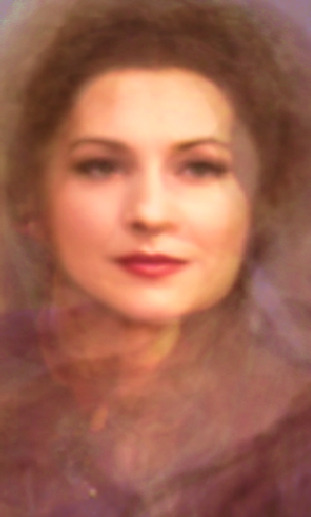
Eh, why not--these composites are really fun to make. So here are more characters from “Phantom” based on mine and @meggiry-khaleesi‘s headcanon appearances!
Top left: Carlotta Giudicelli, based on a mix of Adelina Patti, Marcella Albani, Kristen Chenowith, Rachel Anne Moore, Trista Moldovan, Minnie Driver, Gabriella Zanchi, Jean Harlow, Virginia Pearson, Catherine Tate, Ekaterina Lekhina, Kim Stengel, Audra McDonald, Irina Samoylova, Eartha Kitt, Rosemary Ashe, Magda Olivero, Miriam Hopkins, Madeline Kahn, Paola Barale, and Hazel Court.
Top right: Cecile Jammes, based on a mix of Kara Klein, Melanie Thierry, Aissa Maiga, Lily James, and Sharon Millerchip.
Bottom left: La Sorelli, based on a mix of Bianca Balti, Sophia Loren, Natalie Dormer, Rachelle Ann Go, Asmeret Ghebremichael, Janelle Monae, Ciara Renee, Elizabeth Taylor, and Anna Pavlova.
Bottom right: Madame Giry, based on a mix of the Oslo Norway dance teacher, Liz Robertson, Paula Capovillia, Ellen Harvey, Mary Millar, Anne Kanengeiser, Miranda Richardson, Elena Obraztsova, Marilyn Caskey, Heather Jackson, Nancy Hess, Katharine Alexander, Diana Rigg, Michelle Fairley, Bernadette Peters, and Donna Murphy.
#can't stop won't stop XD#the phantom of the opera#my edits#la carlotta#cecile jammes#la sorelli#madame giry
15 notes
·
View notes
Text

She was the more beautiful of the two — indeed she was the most beautiful member of a very handsome family. Her voice was as rich in quality as Adelina's and its range even higher. Her technical accomplishments were fully as wonderful. She delighted in singing music written specially to show off the violin technic. In all these respects she was as bountifully equipped for the operatic stage as her sister, but the unfortunate mishap in her childhood confined her within the narrow limits of the concert stage. Besides these qualities she not only had genuine feeling and fine sentiment, but decided dramatic ability. It was evidenced in every song she sang. It must have been bitter for her to endure her confinement to the concert- room, and now and then she must have envied the brilliant career of her sister in that particular realm of music for which she was so richly endowed. This feeling once came to the surface. It was in Birmingham, England, in 1871. Her manager imprudently advertised her as " the sister of the celebrated Adelina Patti." The Patti wrath flamed up in her, and she refused to sing. Carlotta Patti's nature was made up of a singular combination of qualities. When among her intimates, she was the very soul of good nature, and I have seen her when she was bubbling over with fun and sparkling with repartee. But with strangers, or persons seeking to make her acquaintance out of mere idle curiosity, she was reserved and forbidding. She was by nature imperious and haughty, quick tempered, and brusque of speech. She was very fond of social functions, although her lameness prevented her from dancing. She was also devoted to dress and personal adornment, and was luxurious in her habits and fond of elegant ease,— conditions which may have been superinduced by her physical impediment. Carlotta Patti's musical career, though confined to the concert stage, was exceptionally brilliant. She made her debut in 1861, and her success was instantaneous. She gave concerts all over this country and Europe, and became a universal favorite. She died in Paris, the city she loved best, in 1889. The gayety and excite- ments of that city just suited her pleasure-craving nature. With one sister queen of the opera, and another sister queen of the concert-room, what was left for Amalia Patti but a quiet, uneventful stage life in this double shadow, the applause only of those who really knew something about music, and devotion to the interests of her manager-husband, Maurice Strakosch? She was graceful and handsome, — all the Pattis were, as I have said. She was an excellent singer, as a matter of course, being a Patti. She had decided talent, but it was not sufficient to place her in the highest rank. Unlike her two more gifted sisters, she had a contralto voice. She was the oldest child of the second marriage, and made her debut in " Beatrice di Tenda," at the Astor Place Opera House, New York, in 1847. Maurice Strakosch first met her in 1848, when arranging a concert tour with Anna Bishop, Parodi, and herself. They were married at the close of that tour, and, as far as I know, " lived happily ever after." She came to Chicago during the tour, again in 1853 with Steffanone, Paul Julien, and her husband, who was an excellent pianist, the most dignified of managers, and most philosophical of men. He always rose superior to the accidents menacing the box-office and the absurd caprices of artists. Amalia Patti' s next concert visit was in 1854 with Ole Bull. Her voice was not a powerful one, nor was it very dramatic, but she was always an enjoyable singer. It was a pleasure to listen to her smooth, quiet, melodious, and well-trained manner of singing, as it was to watch her pretty face, her graceful, high-bred personality, and the quiet elegance of her stage deportment. She appeared many times in Chicago in opera, and while she never roused wild enthusiasm with furious outbursts of declamation or brilliant feats of technic, she was a favorite with musical people because they were confident she would do everything correctly. I have known an
audience to go wilder over a single sforzando of Brignoli's, a high C of Wachtel's, or one trill by Adelina Patti, than they would over an evening of perfect en- sembles. In a word, Amalia's career was colorless because it was continually in the Adelina-Carlotta penumbra.
1 note
·
View note
Text
We love you, Patti
want to know a fun fact?
in gaston leroux’s novel the phantom of the opera, the character of carlotta is based off the sisters carlotta and adelina patti
andrew lloyd webber adapted the book into a musical. he is also notable for being a huge fucking asshole to two time tony winning actress patti lupone
adelina patti’s great grand niece is two time tony winning actress patti lupone.
as alison bechdel says, it all comes back, it all comes back it all comes back
#patti lupone#andrew lloyd webber#the phantom of the opera#adelina patti#la carlotta#carlotta patti#musicals#musical theatre#theatre#musical#opera#books#nerd#book nerd#gaston leroux#broadway#west end
2K notes
·
View notes
Photo

Carlotta Patti (1835-1889); Italian soprano. She came from a very musical family. Her father was the Italian tenor Salvatore Patti and her mother the soprano Catarina Chiesa Barilli. Her sisters Amelia (1831-1915) and Adelina (1843-1919) were also famous sopranos. Her brother Carlo (1842-1873) was a well known violinplayer and conductor. In 1861 she made her debut in a concert at the Academy of Music in New-York. Due to a handicap, which caused a noticeable limp in her walk, she avoided the opera stage and concentrated on concerts.
0 notes
Photo

Carlotta Patti
by Unknown photographer
© National Portrait Gallery, London
CARLOTTA MARIA PATTI ( 1840 – 27 June 1889) operatic soprano Sister to famed soprano Adelina Patti. . Born into a musical family, Patti studied the piano in her youth before following her younger sister's inclination toward singing. As a child, Carlotta developed a handicap which caused a noticeable limp in her walk. Due to this condition she mostly avoided operatic performances and preferred to sing on the concert stage. While not able to achieve her sister's level of acclaim, Carlotta nonetheless received top billing in concerts in the United States of America, Great Britain, and Australia. She was known for her extensive vocal range, reportedly being able to reach a G sharp in altissimo.[4] She often sang songs such as Der Hölle Rache kocht in meinem Herzen that highlighted this extensive range. Carlotta Patti died of cancer in Paris on 27 June 1889.
0 notes